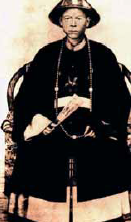Yap Tek Loy, betterknown as Yap Ah Loy, who raised Kuala Lumpur from an obscure mining village to the most important town in the Malay  Peninsula, was born in the village of T’am Shui in Guongdong province, southern China, on 14 March, 1837. He came to Malacca in 1854 and went to work for his clansman in a tin mine at Durian Tunggal. After four months, he went to Kesang to work in the shop of a relative named Yap Ng.
Peninsula, was born in the village of T’am Shui in Guongdong province, southern China, on 14 March, 1837. He came to Malacca in 1854 and went to work for his clansman in a tin mine at Durian Tunggal. After four months, he went to Kesang to work in the shop of a relative named Yap Ng.
In 1856, he went to Lukut and worked for about three years in a tin mine. After he gained enough capital, he went into business for himself as a pig dealer, eventually extending his circuit inland from Lukut to Sungei Ujong. While in Sungei Ujong, he met Liu Ngim Kong, one of the two panglima (head fighter) to Shin Kap, the Kapitan Cina of Sungei Ujong. Through his influence, Yap joined Shin’s party and was appointed an assistant panglima under his clansman Lieu Ngim Kong.
When the Sungi Ujong Malays and Chinese decided to settle their differences after the Sungei Ujong Massacres (in which 4,000 Chinese were killed in six months), Yap was appointed the Kapitan Cina of Sungei Ujong. After Liu Ngim Kong became Kapitan Cina of Kuala Lumpur, he invited Yap to settled in Kuala Lumpur, which he did in 1862. In the years immediately following, Yap prospered and soon became a relatively wealthy man – with a salary as manager of Liu Ngim Kong’s mines, his own two mines, and his shop, Chop Tet Sang, which he opened in 1865.
On Liu Ngim Kong’s death, Yap was appointed the Kapitan Cina of Kuala Lumpur in 1868. During the first years, Yap opened up more mines, eventually employing 5,000 miners. Like the other Kapitans he held the honourary rank of Dato’, giving him the power of life and death over his followers. He could also make such laws as he deemed necessary. Yap soon obtained a reputation for thoroughness, particularly in his treatment of criminals and other troublesome persons. He built a prison large enough to hold 60 people and drew up detailed rules for the punishment of all offenders. However, the prosperous Kuala Lumpur mining areas were destroyed during the Selangor Civil War (1866-1873). Most of the mines were completely flooded out and all the houses, machinery, and property were destroyed.
With the end of the Selangor Civil War and the appointment of a British Resident, Yap was entrusted the task of restoring Kuala Lumpur. He set about the reconstruction of the tin mining industry with great energy. To restore the tine mines to working order, he had to raise funds to repair damaged mines and import more coolies from China. In Kuala Lumpur, he introduced public services and amenities. He set up his house on the south side of the present Old Market Square. By late 1875, he employed 6,000 miners and by 1879, when the price of tin suddenly boomed, Kuala Lumpur had a population of 3,000.
He was a state councillor, magistrate, assessor, and advisor to the British authorities. He constructed roads in and around Kuala Lumpur. He linked up the main mining areas with the town and he laid out streets. He was compensated for the cost of road construction by the grant of permanent titles to the land he occupied in the centre of Kuala Lumpur. He built the section of the road between Damansara and Kuala Lumpur to pay off his debt to the government.
He held approximately two-thirds of the urban land of Kuala Lumpur east of the Klang river. In 1880, there were 220 buildings in Kuala Lumpur of which Yap owned 64, with rents of five to ten Straits dollars a month. He owned the gambling house and the market. After the disastrous fire on 4 January, 1881, which destroyed the whole of Kuala Lumpur, the town was rebuilt in brick or adobe with tile roofs. Then on 21 December, 1881, came the greatest flood ever known, destroying 92 buildings including Yap’s new houses.
In the tin fields around Kuala Lumpur, he held nearly half the area under lease to Chinese miners. His mine on 103ha at Ampang was considered one of the finest in the world. In 1881, he had installed a steam engine for pumping – one of the first in Malaya. He owned a second mine on 28.5ha elsewhere in the Ampang valley. He had 35.5ha at Petaling, 12.25ha at Setapak, and 8.5ha at Pudu. In addition to these mines near Kuala Lumpur, Yap took the lead in opening up new fields in other areas in Selangor during the 1880s. He began with 18.25ha at Kuala Kubu in Ulu Selangor and later increased this to 75ha, he had 16.75ha at Serendah and “a most important one” at Kepong.
At the end of 1884, Yap became ill and he died in the early hours of 15 April 1885. Government offices were closed on the day of his funeral and the Union Jack at the British Residency was flown at half-mast. Jalan Yap Ah Loy in Kuala Lumpur is named after him.
Source: The Expat July 2005
This article was edited for ExaptGo.com
Get your free subscription and free delivery of The Expat Magazine.
"ExpatGo welcomes and encourages comments, input, and divergent opinions. However, we kindly request that you use suitable language in your comments, and refrain from any sort of personal attack, hate speech, or disparaging rhetoric. Comments not in line with this are subject to removal from the site. "


















